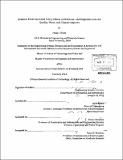Aviation environmental policy effects on national- and regional-scale air quality, noise, and climate impacts
Author(s)
Wolfe, Philip J. (Philip James)
DownloadFull printable version (22.75Mb)
Other Contributors
Massachusetts Institute of Technology. Dept. of Aeronautics and Astronautics.
Advisor
Ian A Waitz.
Terms of use
Metadata
Show full item recordAbstract
The continued growth of the aviation industry poses a challenge to policy-makers and industry stakeholders as each decision represents a trade-off on efficiency, equity, and environmental impact. The Aviation environmental Portfolio Management Tool - Impacts (APMT-Impacts) module has been developed to calculate physical damages from aviation's impact on ambient noise, local air quality, and climate change. The main objective of this thesis is the continued development of a framework for examining aviation environmental policy by expanding the current modeling capability and addressing key shortcomings in decision-making practices. First, climate modeling assumptions, particularly those related to background emissions scenarios and short-lived radiative forcing agents, are examined, and a temperature-response model based on a two-box ocean model with advective flux and diffusion is developed. Second, a cost-benefit analysis of a proposed NOx Stringency policy is performed. The analysis shows that increased engine stringency is not cost-beneficial under several traditional lenses and discount rates. However, lenses accounting for conservative assumptions in air quality and uncertainty in technology cost estimates show benefits for a range of stringency increases highlighting the need for flexibility in the analysis approach, the use of engineering judgment, and open communication between decision-makers and analysts. This cost-benefit analysis is compared to a traditional cost-effectiveness approach. Finally, this thesis lays out the need for supplemental analyses on a regional scale to address who bears the cost and gains the benefits of a given policy.
Description
Thesis (S.M. in Technology and Policy)--Massachusetts Institute of Technology, Engineering Systems Division, Technology and Policy Program; and, (S.M.)--Massachusetts Institute of Technology, Dept. of Aeronautics and Astronautics, February 2012. "February 2012." Cataloged from PDF version of thesis. Includes bibliographical references (p. 129-140).
Date issued
2012Department
Massachusetts Institute of Technology. Department of Aeronautics and Astronautics; Massachusetts Institute of Technology. Engineering Systems Division; Technology and Policy ProgramPublisher
Massachusetts Institute of Technology
Keywords
Engineering Systems Division., Technology and Policy Program., Aeronautics and Astronautics.